In the vast landscapes where cows graze peacefully, it is not uncommon to spot elegant white birds perched atop their backs or following them closely.
This intriguing phenomenon has captivated the curiosity of many nature enthusiasts and researchers alike.
Why do white birds hang around cows? Is there a hidden purpose behind this peculiar companionship? In this article, we delve into the fascinating relationship between white birds and cows, uncovering the secrets of this symbiotic bond.
From mutual benefits to ecological explanations, we explore the various theories that shed light on this captivating phenomenon.
Join us on this journey as we unravel the mysteries behind why white birds hang around cows, revealing the intricate connections that exist within the natural world.
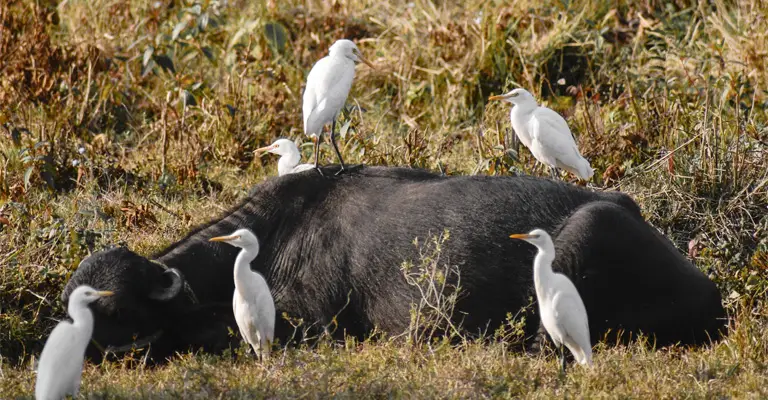
Why Do White Birds Hang Around Cows?
The sight of white birds, such as egrets or herons, hanging around cows is a common occurrence in many rural areas. This peculiar relationship has intrigued scientists and observers alike. Let’s explore the reasons behind this phenomenon:
Foraging Opportunities
One of the primary reasons white birds are often found near cows is the abundance of foraging opportunities. Cows, while grazing, disturb insects and other small organisms in the grass.
These disturbances attract white birds, which have learned to take advantage of easy access to food. The birds feed on the insects that are stirred up by the cows’ movements, creating a mutually beneficial relationship.
Mutualistic Relationship
The relationship between white birds and cows can be classified as mutualistic, as both parties benefit from each other’s presence. While the birds gain a readily available food source, cows benefit from the birds’ presence by having their bodies cleaned of parasites.
White birds, known as “cattle egrets,” perch on the backs of cows and consume ticks, lice, and other parasites that infest the cattle. This symbiotic relationship helps keep the cows healthy and free from harmful pests.
Thermoregulation
Another reason white birds are often seen near cows is thermoregulation. Cows generate a significant amount of body heat, especially during hot weather.
By standing near cows, white birds can take advantage of the warm air currents that rise from the cows’ bodies.
This behavior helps the birds conserve energy by reducing the need for flapping their wings to stay aloft. Additionally, the shade provided by the cows can offer relief from direct sunlight, further aiding in temperature regulation.
Camouflage and Protection
White birds, such as egrets, have evolved to have white plumage, which provides excellent camouflage in certain environments.
When standing near cows, the birds blend in with the cows’ white or light-colored coats, making it easier for them to approach prey without being detected.
This camouflage also offers protection from predators, as the birds can take advantage of the cows’ larger size and defensive behavior.
Nesting Opportunities
Cows provide nesting opportunities for white birds, particularly in areas where natural nesting sites are limited. The branches of trees near grazing pastures are often used by white birds as nesting sites.
By nesting near cows, the birds can benefit from the protection offered by the cows’ presence, deterring potential predators from approaching their nests.
Which White Birds Hang Around Cows?
The presence of white birds around cows is a common sight in many rural areas. These birds have adapted to take advantage of the opportunities provided by the presence of cows.
Here are some of the white bird species that are often found near cows, shedding light on their characteristics and behaviors:
Cattle Egret (Bubulcus ibis)
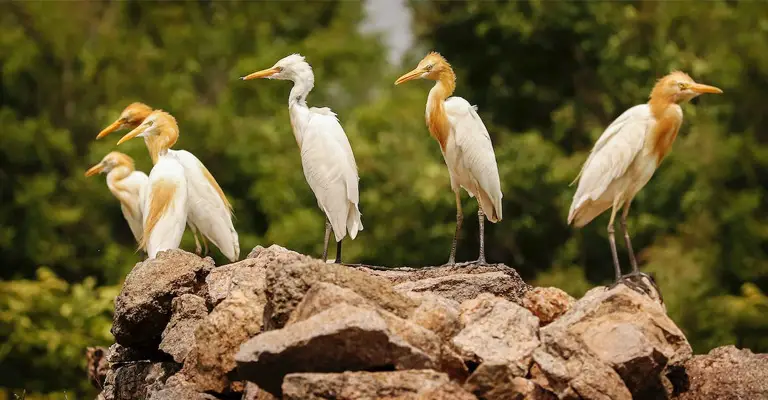
The most commonly observed white bird species around cows is the cattle egret. These medium-sized birds have white plumage, a yellow bill, and yellow legs.
Cattle egrets are native to Africa but have expanded their range to other parts of the world, including Europe, Asia, and the Americas.
They are known for their symbiotic relationship with cows, as they perch on their backs and feed on insects and parasites that infest the cattle.
Cattle egrets are highly adaptable and can be found in a variety of habitats, including grasslands, wetlands, and agricultural areas.
Great Egret (Ardea alba)
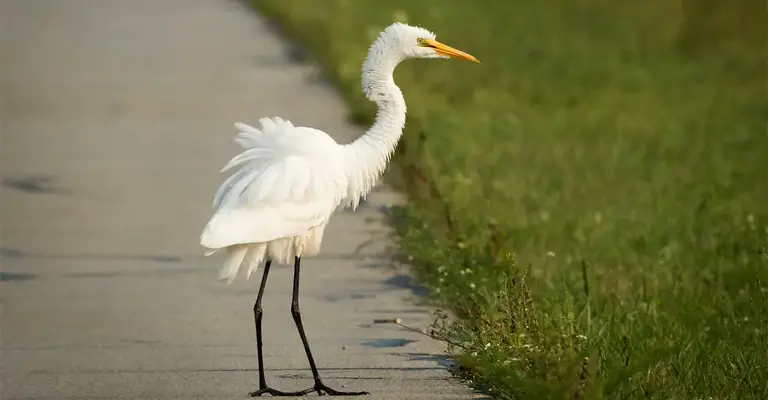
The great egret is another white bird species that can often be seen near cows. These large birds have white plumage, a long neck, and a yellow bill.
Great egrets are found in various parts of the world, including North America, Europe, Asia, and Africa.
While they are not as closely associated with cows as cattle egrets, they may be attracted to the same foraging opportunities that cows create.
Great egrets feed on a variety of prey, including fish, frogs, insects, and small mammals. Their elegant appearance and graceful movements make them a captivating sight when observed near cows.
Snowy Egret (Egretta thula)
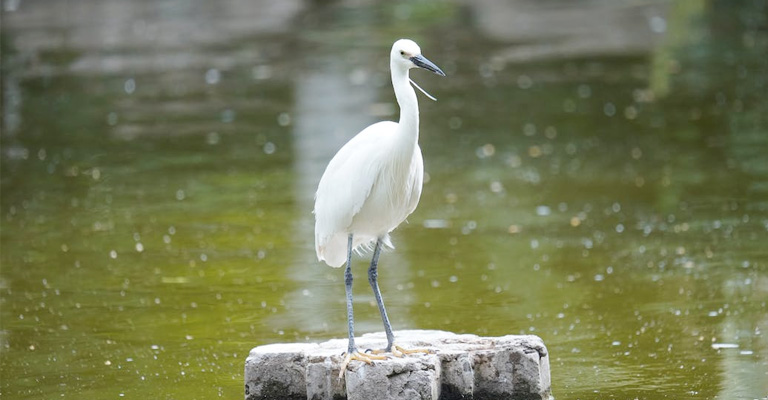
Snowy egrets are small to medium-sized white birds that can also be found near cows in certain regions. They have white plumage, a slender black bill, and distinctive yellow feet.
Snowy egrets are native to the Americas and can be found along coastlines, marshes, and other wetland habitats.
While they primarily feed on fish and aquatic invertebrates, they may take advantage of the insects and small organisms stirred up by cows while grazing.
Snowy egrets are known for their active foraging behavior, where they use their bright yellow feet to stir up prey in the water.
Little Egret (Egretta garzetta)
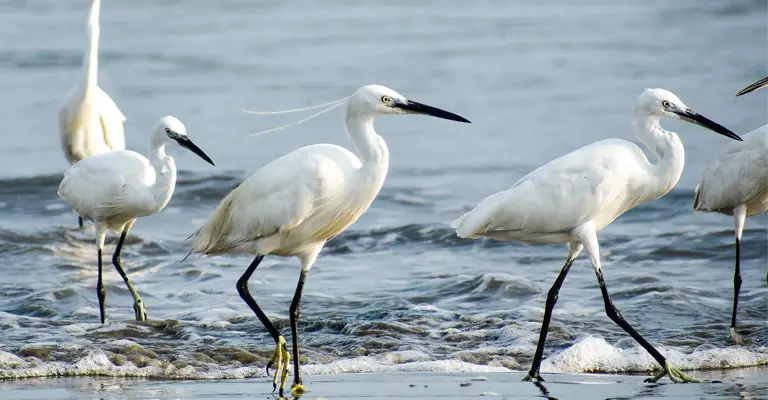
The little egret is a white bird species that is commonly found near cows in Europe and parts of Asia. They have a white plumage, a slender black bill, and black legs. Little egrets are often seen in wetland habitats, including marshes, estuaries, and rice fields.
While they primarily feed on fish, amphibians, and small invertebrates, they may also take advantage of the insects and other small organisms disturbed by cows.
Little egrets are known for their graceful hunting techniques, where they patiently stalk their prey before striking with precision.
How Cows Are Benefitted from This Symbiotic Relationship with Birds?
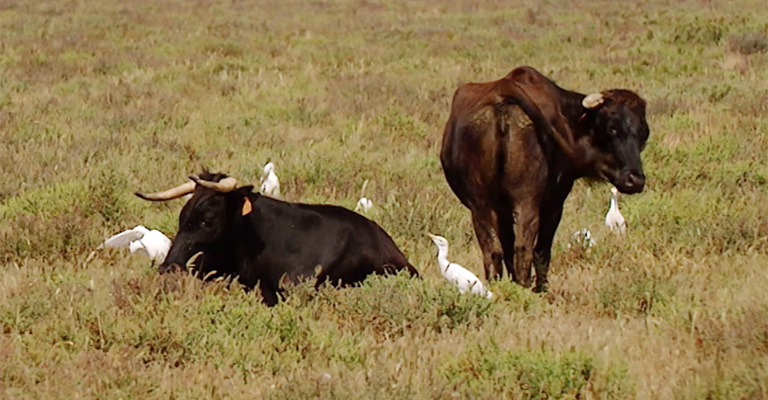
Cows benefit from the symbiotic relationship with birds in several ways. Here are some of the ways cows are benefited from their association with white birds:
Parasite Removal
One of the significant benefits for cows is the removal of parasites. White birds, such as cattle egrets, perch on the backs of cows and consume ticks, lice, and other parasites that infest the cattle.
By feeding on these parasites, the birds help keep the cows free from harmful pests. This reduces the discomfort and potential health issues caused by parasites, leading to improved overall well-being for the cows.
Reduced Stress
Parasite infestations can cause stress and discomfort for cows. By having white birds around, the cows experience relief from the constant irritation caused by parasites.
The birds’ presence and their active consumption of parasites provide a natural form of pest control, reducing the stress levels of the cows. This, in turn, can positively impact the cows’ behavior, productivity, and overall health.
Improved Hygiene
The presence of white birds around cows contributes to improved hygiene. Parasites, such as ticks and lice, can carry diseases and cause skin irritations in cows.
By consuming these parasites, the birds help prevent the spread of diseases and reduce the likelihood of skin infections. This leads to cleaner and healthier cows, promoting better overall hygiene within the herd.
Mutualistic Relationship
The relationship between cows and white birds can be classified as mutualistic, as both parties benefit from each other’s presence.
While the birds gain a readily available food source by feeding on insects stirred up by the cows, the cows benefit from parasite removal and improved hygiene.
This mutually beneficial relationship helps maintain a balance in the ecosystem and contributes to the well-being of both species involved.
Natural Pest Control
White birds contribute to natural pest control for cows. Insects, such as flies and mosquitoes, can be a nuisance for cows, causing irritation and potential health issues.
The presence of white birds attracts and consumes these insects, reducing their population and minimizing the annoyance and potential harm they can cause to the cows.
This natural form of pest control can help reduce the need for chemical insecticides or other interventions, promoting a more sustainable and environmentally friendly approach to managing pests.
Do Birds Attack Cows?
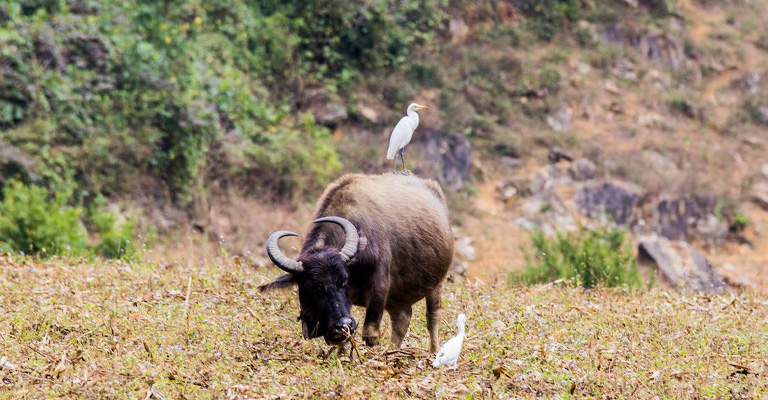
Birds do not typically attack cows. Cows are large herbivores that are not considered natural prey for most bird species.
Birds, especially smaller ones, are more likely to focus on finding food sources, building nests, or engaging in other behaviors that are essential for their survival.
However, there are some instances where birds may exhibit behavior that could be perceived as attacking cows.
For example, certain bird species, such as crows or ravens, have been observed pecking at cows.
This behavior is often related to the birds’ attempt to remove parasites or insects from the cows’ skin. In these cases, the birds are not attacking the cows out of aggression but rather engaging in a symbiotic relationship.
The birds benefit from the insects they find, while the cows benefit from having the parasites removed. It’s important to note that such interactions are relatively rare and do not pose a significant threat to cows.
The vast majority of bird species do not pose any harm to cows and coexist peacefully with them in their natural habitats. Cows, being large and powerful animals, are generally not targeted by birds as prey.
FAQs
White birds, such as egrets or herons, hang around cows primarily for foraging opportunities and mutualistic relationships. The disturbances caused by cows while grazing attract insects and other small organisms, which serve as a food source for the birds.
White birds benefit from being around cows by gaining easy access to food. The disturbances caused by cows while grazing stir up insects, making them readily available for the birds to feed on.
White birds help cows in several ways. They consume parasites, such as ticks and lice, that infest the cows, providing natural pest control and reducing the discomfort and potential health issues caused by these parasites.
Yes, white birds have additional reasons for being around cows. They take advantage of the warm air currents and shade provided by cows for thermoregulation, conserving energy, and finding relief from direct sunlight.
Yes, there are specific white bird species that are commonly found near cows. The most commonly observed species is the cattle egret, known for its symbiotic relationship with cows.
Other white bird species that can be seen near cows include the great egret, snowy egret, and little egret.
Bottom Line
As we conclude our exploration of the relationship between white birds and cows, we are left with a deeper appreciation for the intricate connections that exist within the natural world.
While the exact reasons for this unique companionship may vary, it is clear that both species benefit from their symbiotic bond.
Whether it is the birds finding a reliable source of food and protection or the cows enjoying the benefits of pest control, this partnership highlights the interdependence and harmony that can be found in nature.
As we continue to unravel the mysteries of the animal kingdom, let us remember that even the most unexpected alliances can teach us valuable lessons about the delicate balance of ecosystems.
So, the next time you spot a white bird perched upon a cow’s back, take a moment to marvel at the wonders of nature’s intricate web of connections.